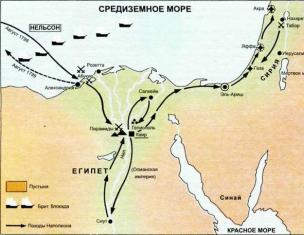Baby! Don't be afraid to learn something new! If you know numbers in Russian, then you will definitely know how they are written and pronounced in English. In that distant country of England, numbers are written and pronounced a little differently, they are not at all complicated. Now let's look a little at the history of numbers.
A short course on the history of numbers
There used to be primitive people, they were exploring this world, just like you are now. And they noticed that they had five fingers on each hand. Look at your hand now. Do you see? You have five fingers. And the second hand has five fingers. And if you add them up, it turns out that you have ten fingers on both hands. People realized that numbers could be written down somehow, for example on stones, because there were no pens and pencils then.
You may ask, why should I write it down? Well, you can, for example, write down a number on paper and remember that they bought you two ice creams yesterday and now you already need three ice creams. Now we will stop at the history course and move straight to the numbers.
Table of numbers from 1 to 20
| Number | Number name in English | Transcription of English numerals | Approximate pronunciation of an English number in Russian | The name of the English number in Russian |
| 0 | zero | [´ziərəu] | ´zierou | zero |
| 1 | one | one | one | |
| 2 | two | that:* | two | |
| 3 | three | [θri:] | sri:** | three |
| 4 | four | fo: | four | |
| 5 | five | five | five | |
| 6 | six | syx | six | |
| 7 | seven | sevn | seven | |
| 8 | eight | eith | eight | |
| 9 | nine | nain | nine | |
| 10 | ten | ten | ten | |
| 11 | eleven | i´levn | eleven | |
| 12 | twelve | tuelv | twelve | |
| 13 | thirteen | [θə:´ti:n] | sho´ti:n** | thirteen |
| 14 | fourteen | fo´ti:n | fourteen | |
| 15 | fifteen | fifty:n | fifteen | |
| 16 | sixteen | syx´ti:n | sixteen | |
| 17 | seventeen | sevn´ti:n | sevn´ti:n | seventeen |
| 18 | eighteen | hey:n | eighteen | |
| 19 | nineteen | nain´ti:n | nineteen | |
| 20 | twenty | [´twenti] | tu´enti | twenty |
Want to learn more numbers? For example.
The topic of English numerals is quite complex, since the formation of English numerals differs from the formation of Russian ones. There are rules, and there are exceptions, and both have their own peculiarities. Let's look at English numbers with transcription and Russian pronunciation, give vivid examples and focus on exceptions. Go ahead for new knowledge!
Numbers in English are formed in different ways. Numerals from 1 to 10 have some rules of formation, from 13 to 20 - others. Tens, hundreds and thousands also have peculiarities of education.
Features of the formation of numerals from 1 to 12
The table below shows the numerals from 1 to 12 with transcription, Russian pronunciation and examples:
| 1 | one | one | |
| 2 | two | [ˈtuː] | that |
| 3 | three | [θriː] | sri |
| 4 | four | odds | |
| 5 | five | five | |
| 6 | six | syx | |
| 7 | seven | [ˈsevn] | s'even |
| 8 | eight | eith | |
| 9 | nine | nain | |
| 10 | ten | heating element | |
| 11 | eleven | [ɪˈlevn̩] | il'even |
| 12 | twelve | tU'elv |
- We wanted one cake, two bananas ang eight apples => We wanted one cake, two bananas and eight apples.
- We need to buy avocado fot this recipe. Or better two ones => For this recipe we have to buy an avocado. Or better yet, two.
- Three kilos of meat, four big tomatoes, five eggplants and garlic will make this evening much more better. I will prepare very delicious dish by my own recipe! => Three kilograms of meat, four large tomatoes, five eggplants and garlic will make the evening much better. I will prepare a very tasty dish according to my own recipe!
- Eleven foxes and twelve wolves were seen on this week at this place => Eleven foxes and twelve wolves were seen this week at this place.
Features of the formation of numerals from 13 to 20
| 13 | thirteen | [θɜː’tiːn] | sert'in |
| 14 | fourteen | [ˌfɔː’tiːn] | fort'in |
| 15 | fifteen | [ˌfɪf’tiːn] | fifty'in |
| 16 | sixteen | [ˌsɪk’stiːn] | sykst'in |
| 17 | seventeen | [ˌsev(ə)n’tiːn] | Seventh'in |
| 18 | eighteen | [ˌeɪ’tiːn] | eit'in |
| 19 | nineteen | [ˌnaɪn’tiːn] | night'in |
The table shows that numerals from 13 to 19 (inclusive) are written according to the same rules; a particle is added to the cardinal number (one, two, three) –teen. And do not confuse cardinal numbers with ordinal numbers! in English they are formed in a completely different way!
Note! It must be remembered that every rule has exceptions. In this case, the exceptions will be the numerals 13 and 15. Their roots three and five will have a modified form:
- Three => thirteen
- Five => fifteen.
Not threeteen/fiveteen!!!
Some examples:
- Seventeen girls were seen at this party while only eight boys came. — Seventeen girls were seen at the party, while only eight guys came.
- Seventeen pieces of cake were given to all those children. — All these children were given seventeen pieces of pie.
- There is a lot of fish in this river. Nineteen kinds were known 5 years ago. — There are a lot of fish in this river. Five years ago, nineteen species were known.
Tens of English numerals
| 20 | twenty | [ˈtwenti] | tU'enti |
| 30 | thirty thirty | [ˈθɜːti] | S'yorti |
| 40 | forty | [ˈfɔːti] | f'orti |
| 50 | fifty | [ˈfɪfti] | f'ifti |
| 60 | sixty | [ˈsɪksti] | s’yksti |
| 70 | seventy | [ˈsevnti] | s'eventi |
| 80 | eighty | [ˈeɪti] | ‘hey |
| 90 | ninety | [ˈnaɪnti] | n'ainti |
The table clearly shows that tens of numbers are formed using a particle (suffix) –ty. These numerals are derivatives of cardinal ones, but you also need to add the suffix –ty.
Important! Remember that when forming the numbers 20,30, 40 and 50, the root of the cardinal digits, which serve as the basis for the formation of tens, will change:
- two – 20 twenty [ˈtwenti]
- three – 30 thirty [ˈθɜːti]
- four – 40 forty [ˈfɔːti]
- five – 50 fifty [ˈfɪfti]
And one more nuance: the number 80 [ˈeɪti] is characterized by the absence of repetition of the letter t: eight (eight) = eighty(eight+ty =eightty).
Examples:
- Thirty exotic animals were needed to make the idea of the movie complete => Thirty exotic animals were needed to make the idea of the movie complete.
- Sixty soldiers will come on parade in front of the palace=> Sixty soldiers will come to the parade in front of the palace.
- Fifty of them knew the road but only thirty agreed to follow us => Fifty of them knew the road, but only thirty agreed to follow us.
As for the stress of numerals that are formed with the help of –ty, then everything is simple - stress Always will be on the first syllable.
Reference: It happens that it is difficult for beginning students to divide colloquial speech numerals with –ty and –teen. And here stress comes to the rescue - if it is on the first syllable, then 100% we are dealing with tens of numerals.
Basics: How numbers are formed in English
When studying the formation of English numbers, it is important to remember that numbers from 1 to 12 are simple cardinal numbers. Their task is to indicate the number of objects. Such numerals consist of one word. It is very important to remember the spelling of the first twelve digits, since they are the basis for the formation of all other digits - from thirteen to a billion.
How to pronounce numerals that are formed by adding the particle –teen? Here you need to be very careful => the pronunciation of numerals (English numbers) will have two stresses: on the first and second syllable. At the same time, we immediately note that the stresses will not be equal in strength. One of them will be secondary, and the other will be primary.
For example, how do you pronounce thirteen? From the transcription of [ˌθɜːˈtiːn] it is clear that the word has two stresses. The bottom line indicates secondary stress, the top line indicates primary stress. The same goes for fourteen [ˌfɔːˈtiːn] and fifteen [ˌfɪfˈtiːn]. There are also two stresses here – main and additional.
What to do to avoid making mistakes with pronunciation? To do this, you should always look at the transcription. Each numeral, like any other word, should be studied according to the following scheme: transcription - translation - the presence of several meanings.
Pay attention! In some dictionaries, the stress of numerals is determined by the presence (absence) of a noun after it. For example, if a numeral is next to a noun, then the stress falls on the first syllable =>
- fifteen rivers [ˈfɪftiːn ˈrɪvər z]
- sixteen cats [ˈsɪkstiːn ˈkæts]
But! If a numeral stands alone in a sentence, without a noun, then the stress falls on the second syllable (on the suffix –teen):
- fifteen
- sixteen
Examples:
- Fifteen cats were sold this week (emphasis is on the first syllable) => Fifteen cats were sold this week
- How many cats were sold this week? – Fifteen (emphasis on the suffix –teen) => How many cats were sold this week? - Fifteen.
A hundred, a thousand, a million: is there a difference?
First of all, it should be noted that before the numerals hundred (one hundred), thousand (thousand) and million (million) there will always be either the word one or the indefinite article a (meaning ‘one’).
- a/one hundred => One h’andrid [ə wʌn ˈhʌndrəd]
- a/one thousand => One Southend
- one million => One m'ilyan.
- One hundred and twenty => one hundred and twenty
- One hundred singers => one hundred singers
- One hundred thirty eight cars => one hundred thirty eight cars.
But! Other cardinal numbers are characterized by the absence of an article! =>
- Five dresses => Five dresses.
- Eight balls => Eight balls.
Important! The numerals hundred, thousand and million do not have the ending –s, which determines the plural.
- Two hundred => two hundred
- Five hundred => five hundred
- Nine hundred => nine hundred, etc.
If we are talking about thousands, then the same rule applies:
- thousand (one thousand) – one thousand or a thousand
- five thousand – five thousand
- seven thousand – seven thousand.
Millions are formed by the same principle:
- million (one million) – one million or a million
- seven million – seven million
- nine million – nine million.
But! English wouldn't be as fun to learn if it didn't have exceptions. What would it be like without them? Students will be interested to know that the ending –s in millions, thousands and hundreds is still used. When does this happen? When measures denote an indefinite number of these same millions, thousands and hundreds.
Examples
- Hundreds of pages to read for understanding => Read hundreds of pages to understand (something, foreign language, For example).
- Five millions of tons of gold => Five million tons of gold.
- Thousands of kilometers to walk to win marathon => Walk thousands of kilometers to win the marathon.
From the examples it is clear that after hundreds, thousands and millions with the ending –s (when translated into English) comes a noun or verb. In most cases, the additional part of the sentence will still be a noun. And if it is present, it must be with the preposition of:
- Seven or eight thousand of specie were made of pure silver => Seven or eight thousand metal coins were made of pure silver.
A song about English numbers for children
Let's sum it up
Numbers in English are formed in a different way from the one we studied in Russian grammar. Tens and hundreds have their own characteristics of education, in which, naturally, there will certainly be exceptions to the rules. At the same time, in order to learn numerals correctly, it is extremely important to learn how to pronounce them correctly.
When writing numerals, they also have their own nuances; you also need to know the subtleties of spelling. Therefore, we are learning the topic of English numbers with transcription and Russian pronunciation little by little and with examples (translation) in order to better understand the intricacies of the material. And don’t forget to regularly review the topics you’ve already studied so that you don’t forget them.
Good luck and new achievements! Remember that everything was not given to anyone at once. Start small and gradually develop your abilities. If you want, you will succeed! See you again and more interesting topics for studying!
A couple more videos on the formation of English numbers from 1 to 100 and from 100 and above from an English-speaking teacher:
What can’t a person starting to learn English do without? What should your child learn for school? Without which you can't even tell what time it is? Of course, without numbers. Learning numbers in English is quite easy. You can learn them with the help of interesting color pictures, you can sing them like a song, you can memorize them like a tongue twister - there is room for imagination and creativity!
How to say numbers in English
Let's list the main numbers in English:
- 0 – zero – zero;
- 1 – one – one;
- 2 – two – two;
- 3 – three – three;
- 4 – four – four;
- 5 – five – five;
- 6 – six – six;
- 7 – seven – seven;
- 8 – eight – eight;
- 9 – nine – nine.
They don't give in general rules formations are the following numbers:
- 10 – ten – ten;
- 11 – eleven – eleven;
- 12 – twelve – twelve;
- 100 – hundred – one hundred;
- 1000 – thousand – thousand.
How to pronounce them correctly in English?
You can pronounce numbers correctly, and all other words of the English language, only by knowing the transcription. Transcription is a special recording of a word as it is pronounced (for example, Russian word“to show off” can be written transcriptionally as [risavaca]). And learning English numbers with transcription is much easier than without it.
Here's how the English numbers are read:
- 0 – 🔊 Listen zero – [‘ziərəu];
- 1 – 🔊 Listen one – ;
- 2 – 🔊 Listen two – ;
- 3 – 🔊 Listen three – [θri:];
- 4 – 🔊 Listen four – ;
- 5 – 🔊 Listen to five – ;
- 6 – 🔊 Listen to six. – ;
- 7 – 🔊 Listen seven – [‘sev(ə)n];
- 8 – 🔊 Listen eight – ;
- 9 – 🔊 Listen to nine –;
- 10 – 🔊 Listen ten – ;
- 11 – 🔊 Listen eleven – ;
- 12 – 🔊 Listen to twelve – ;
- 100 – 🔊 Listen hundred – ;
- 1000 – 🔊 Listen to thousand – [θʌuzend].
But what if you don’t know how the transcription is read? For those who are just about to learn English from scratch, numbers with Russian transcription will be very useful:
- 0 – zero – [zero];
- 1 – one – [one];
- 2 – two – [that];
- 3 – three – [sri];
- 4 – four – [fo];
- 5 – five – [five];
- 6 – six – [six];
- 7 – seven – [seven];
- 8 – eight – [ate];
- 9 – nine – [nine];
- 10 – ten – [ten];
- 11 – eleven – [ileven];
- 12 – twelve – [tvelv];
- 100 – hundred – [handred];
- 1000 – thousand – [southend].
All possible numbers, the largest numbers imaginable, are just combinations of nine digits, from zero to nine. Numbers are formed according to special rules.
Rules for forming numbers in English
In general, numbers in English can be divided into:
simple;
derivatives;
compound.

Understanding which number is which is very simple. Simple consist of one word (for example: five, nine, thousand). Derivatives consist of one word, but at the same time have the suffixes –teen (from 13 to 19) or –ty (tens from 20 to 90). Composite but, as their name suggests, they consist of several numerals.
How to form derivative numerals?
To form derivatives of the numbers 13 to 19, take a number from 3 to 9 and add the suffix –teen. Some letters may change! Be careful!
13 – three + teen = thirteen;
14 – four + teen = fourteen;
15 – five + teen = fifteen;
16 – six + teen = sixteen;
17 – seven + teen = seventeen;
18 – eight + teen = eighteen;
19 – nine + teen = nineteen.
The stress in these numerals will fall on the suffix. The numerals are read in accordance with the transcription of the first parts (for example: fifteen - [fiftin], eighteen - [eitin]).
To form derivatives of numbers from 20 to 90, take the number from 2 to 9 and add the suffix –ty.
20 – two + ty = twenty;
30 – three + ty = thirty;
40 – four + ty = forty;
50 – five + ty = fifty;
60 – six + ty = sixty;
70 – seven + ty = seventy;
80 – eight + ty = eighty;
90 –nine + ty = ninety.
The stress in these numerals will fall on the root. They are read in the same way as the first parts: (for example: sixty - [sixty], forty - [foti]).
How to form compound numbers?
Compound numerals are formed using tens + ones (if the number is less than a hundred), hundreds + tens + ones (if the number is less than a thousand), etc.
For example, let's say you want to form the number "twenty-one". You need to write two words: “twenty” and “one”. Thus, twenty-one is twenty-one! At the same time double figures are written with a hyphen.
Similarly, you can form any numbers up to a hundred:
Fifty-three – fifty + three = fifty-three.
Forty-nine – forty + nine = forty-nine.
Seventy two – seventy + two = seventy-two.
Thirty-six – thirty + six = thirty-six.
Ninety-nine – ninety + nine = ninety-nine.
Counting within the first two tens with the transition through the rank is very complex topic for first-graders.
And not only for them. Not everyone can easily and quickly add and subtract numbers beyond ten.
Therefore, I suggest downloading this notebook, or rather, a set of sheets with tasks.
The examples have already been written here; the solutions need to be written in the boxes. Therefore, it is easier for the child not to have to rewrite these examples on his own.







Download: (downloads: 1452)
Dear readers!
All materials from the site can be downloaded absolutely free. All materials have been scanned by antivirus and do not contain hidden scripts.
The materials in the archive are not marked with watermarks!
The site is updated with materials based on free work authors. If you want to thank them for their work and support our project, you can transfer any amount that is not burdensome to you to the site’s account.
Thank you in advance!!!
Numbers surround us everywhere. Perhaps this is why children remember them so easily, without delving into the meaning and significance. For a first-grader, counting is one of the fundamental principles of learning. It is better to introduce your child to counting before school to make it easier to integrate into educational process and not experience much stress.
It is important to start learning with early age. At two years old, a child’s brain is already capable of remembering counting. If you leave everything to chance, there is a risk that mathematical thinking appears only at 10 years old.



How to get interested?
However, at first, interest in counting can be awakened in the simplest ways:
- We count everything we see– steps, trees, steps, flowers, people. Start yourself, and the child will take the initiative, thereby memorizing the numbers.



- Compare- Offer your child a sweet way - candy. Take different quantities of them and offer to compare them. First, these will be the words “more”, “less”, and then you can move on to numbers and introduce the concept “by how much”. You can use large beads, toys from Kinder Surprise, cars and similar elements.
- Find the number– offer your child a book or magazine with numbers. Name the number and play detective - look for it on the pages and pictures.
- Let's launch a rocket– this exercise helps teach your child how to count backwards from 10 to 1.



It is important to take into account the child’s mood and not be intrusive. Next, see which method of counting is interesting to your child. If you don’t like sticks, consider candies, apples, and favorite toys.
One more thing important rule– don’t complicate things. No need to give right away difficult tasks. However, too simple examples, learned by heart by a child, can quickly get boring and discourage new knowledge.
The key is repetition. Don’t pay attention to the fact that someone else’s Petya or Masha think it’s better and faster. Everything is individual, and everyone needs to find their own approach.
Stop the activity if your child gets tired. In general, class time should not exceed 10 minutes at a time. You can start counting several times throughout the day. It is best to do this when the little student takes the initiative. Learn by playing. The lesson should not turn into a professor's lecture, which will be uninteresting to the child.



Count to 20
In order for a child to remember numbers after 10 well, you will need 20 identical objects - sticks, cubes, small toys. Naturally, First of all, it is necessary that the baby can count to ten
We lay out two rows of ten items each. It is necessary to explain to the child that numbers after 10 are similar. It's just that each of them is preceded by a unit, which means ten. That is, as many rows of cubes as there are tens, that means there are twenty in the number, two times ten cubes. This will help study further figures.



Next, we explain that to the usual numbers one, two, three, and so on, you need to add the ending “eleven.” To make it easier, in the second row we change the number of cubes and ask the child to name the resulting number.
For clarity, the cubes can be numbered so that the child can form a visual image of the number. However, when making calculations, do not confuse the numbers, otherwise the sequence and the arithmetic result will lead the child into a dead end. For calculations, remove the number from the cubes.



Solving Examples
Learning to add and subtract quickly will be difficult. The key here is repetition. The more often a child practices, the faster he will learn to count in his head.
To begin with, let your child “swing” and start solving easy problems up to 10. Then you can start to the second ten.
We again arrange the sticks or cubes in two rows of ten. For better memorization, say the names of the numbers of the second ten when laying out. For example, ten plus one is eleven, ten plus two is twelve, and so on. Set examples for your child, write them on a piece of paper so that the child sees the image.



Explain that you only need to change objects in the second ten when it comes to addition from ten. Lay out 10 cubes and ask your child to add five and announce the result. Once you learn how to add, move on to subtraction. Explain that now you need to remove the extra cubes.
At first, try not to confuse the tens and not to collect the cubes in one pile. It is important to remember tens and ones and arrange rows and results in tens. If the counting does not go through tens, and the child can count to twenty, then the rows can be ignored. For example, 8+8 can be added without using decimal rows.


Calculation using tens
There is another way of counting, where a child learns to count using tens, where it is important to maintain rows so that it is clear how much of a ten a particular number takes.
That is, in the example 8+8 we will be guided by tens. You can move the 8 cubes a little further. Then the child must figure out how many cubes are left in the first ten for the second eight - that's two, and how many need to be added from the second ten - that's six. This method will force the child to train his memory and counting to ten in his head. The same goes for subtraction. We remove the ten from the number, and then arrange it into the second ten. That is, in example 14 -7, we make 14 from ten and four. Next, we explain to the child that from the number 7 there are 4 ones, which means that in order to get 7, you need to take 3 more cubes from the ten, since 3 + 4 = 7. Next comes counting the remaining cubes.


To help your child understand what this action looks like digitally, write examples on a piece of paper. In the first case it will be 8+ (2+6) = 16, and in the second 14- (4+3) = 7.
At first, this method will be difficult for the child. But when the account base is formed, he will quickly master this interesting way and it will be easy to count in your head without using any counting materials.
Methods of teaching counting
Everyone develops differently, so more training methods may be needed. It’s even better to alternate them so that the child has different ideas about counting and is not frightened by school innovations. However, obsession can also confuse, so there should be a decent gap between techniques. As soon as the child masters one and feels like a fish in water, you can start another:
- Fingers. The most famous and practical technique. Fingering helps both visual memory and fine motor skills. For counting the second ten, visual images will also develop while considering how many fingers you need to add and what the result will be. This method is also suitable for counting in tens.

- Counting toys. We learn to add and subtract large numbers on cubes, sticks, and toys. We write examples in a notebook and invite the child to write down the answers. Next, the child can write an example himself under the dictation of an adult. The game of dominoes, where a number is depicted on one side of the domino and objects on the other, will be a great help. By playing with them, the child will be able to compare and mentally correlate the number of things and the number.
- Books and flashcards for learning. Training for kids who already count. Perfectly strengthens skills and promotes better memorization and visualization of the account. Many different magazines with step-by-step solutions to examples, counting the number of things and comparison will allow you to game form perform arithmetic operations. Moreover, you can learn to count on your own, without the help of an adult.



How younger child, the easier it is to teach him to count. After all, then it happens in the form of a game and is not perceived as a task. The main thing in this process is consistency and clarity. How older child, the more different counting methods you can use.
In this case, your child will be ready to learn and will easily cope with tasks in mathematics lessons at school.











